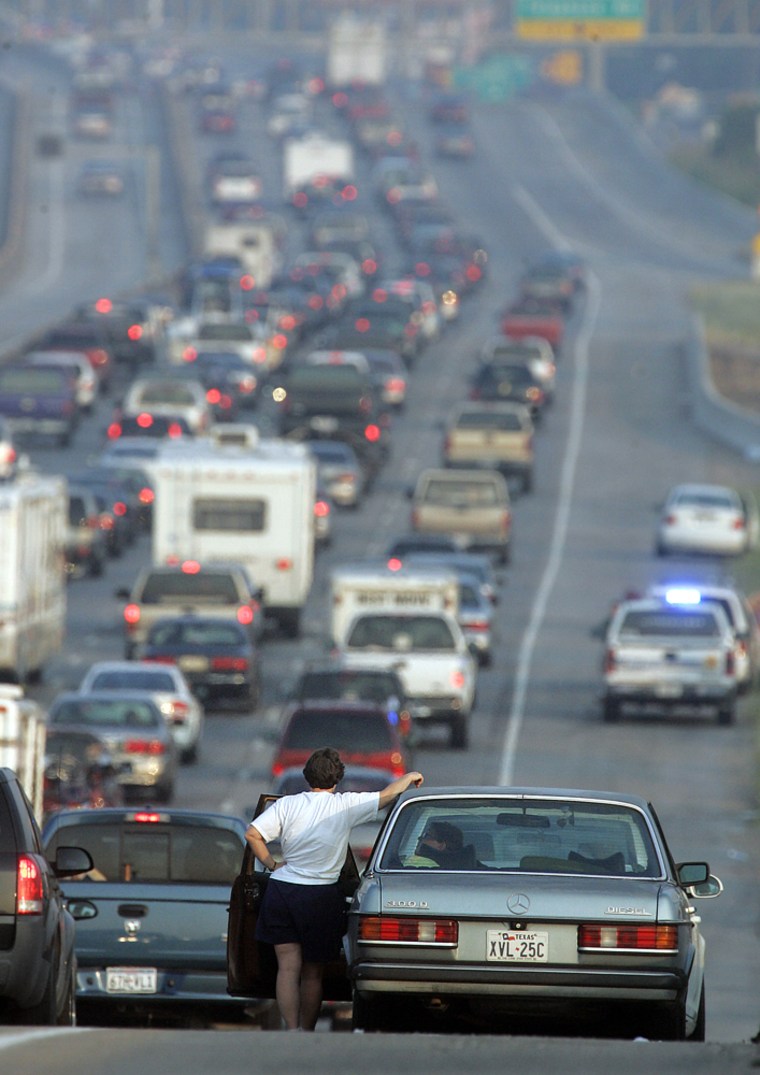Traffic came to a standstill and gas shortages were reported Thursday as hundreds of thousands of people in the Houston metropolitan area rushed to get out of the path of Hurricane Rita, a monster storm with 165 mph winds.
More than 1.3 million residents in Texas and Louisiana were under orders to get out to avoid a deadly repeat of Katrina.
The Category 5 storm weakened slightly Thursday morning, and forecasters said it could be down to a Category 3 — meaning winds as high as 130 mph — by the time it comes ashore late Friday or early Saturday. But it could still be a dangerous storm — one aimed straight at a section of coastline with the nation’s biggest concentration of oil refineries.
Highways leading inland out of Houston were gridlocked, with traffic bumper-to-bumper for up to 100 miles north of the city. Gas stations were reported to be running out of gas. Shoppers emptied grocery store shelves of spaghetti, tuna and other nonperishable items.
All highway lanes opened for evacuation
To speed the evacuation out of the nation’s fourth-largest city, Gov. Rick Perry halted all southbound traffic into Houston along Interstate 45 and took the unprecedented stop of opening all eight lanes to northbound traffic out of the city for 125 miles. I-45 is the primary evacuation route north from Houston and Galveston.
Police officers along the highways carried gasoline to help people get out of town.
At 11 a.m. ET, Rita was centered about 460 miles southeast of Galveston and was moving at near 9 mph. It winds were 165 mph, down slightly from 175 mph earlier in the day. Forecasters predicted it would come ashore somewhere between the Houston-Galveston area and western Louisiana.
Hurricane-force winds extended 85 miles from the center of the storm, and even a slight rightward turn could prove devastating to the Katrina-fractured levees protecting New Orleans. Engineers rushed to fix the city's pumps and fortify its levees.
“Now is not a time for warnings. Now is a time for action,” Houston Mayor Bill White said.
He added: “There is no good place to put a shelter that could take a direct hit from a Category 5 hurricane. I don’t want anybody out there watching this and thinking that somebody is bound to open a local school for me on Friday, not with a hurricane packing these kinds of winds.”
Forecasters said Rita could be the strongest hurricane on record ever to hit Texas. Only three Category 5 hurricanes, the highest on the scale, are known to have hit the U.S. mainland — most recently, Andrew, which smashed South Florida in 1992.
Crude oil prices rose again on fears that Rita would destroy key oil installations in Texas and the gulf. Hundreds of workers were evacuated from offshore oil rigs. Texas, the heart of U.S. crude production, accounts for 25 percent of the nation’s total oil output.
Rita is the 17th named storm of the Atlantic hurricane season, making this the fourth-busiest season since record-keeping started in 1851. The record is 21 tropical storms in 1933. The hurricane season is not over until Nov. 30.
